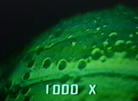Facts about the capsule
• The capsule was traveling 28,860 mph when it entered the atmosphere, the fastest of any re-entry vehicle.
• The capsule's temperature reached 4,900 degrees Fahrenheit during re-entry — twice as hot as lava from Hawaii's Mauna Kea volcano.
• Stardust's roundtrip of 2.9 billion miles is the longest for any spacecraft that has returned to Earth.
• The mission tested a new type of heat shield, which worked so well that some of the original paint survived the plunge through the atmosphere.
• Weighing 850 pounds at launch, the spacecraft body is smaller than a refrigerator.
• The Stardust body was boosted into solar orbit after it released the capsule. NASA says it could be used again to photograph another comet, though it can't be used to collect any more particles.
Source: NASA Jet Propulsion Laboratory

NASA
The Stardust capsule, which measures less than 3 feet across, tumbled across a dried Utah lake bed after touching down early Sunday morning but appeared undamaged.

DOUGLAS C. PIZAC / AP
Ron Ceeders, a Lockheed Martin technician, unbolts a canister containing comet dust from the Stardust capsule in a clean room at Dugway Proving Ground, Utah, on Sunday. Dirt from the desert landing site cakes the exterior of the capsule.

NASA/AMES RESEARCH CENTER
"It looked like a magic wand" is how University of Washington astronomer Don Brownlee described the Stardust capsule's re-entry, seen here from NASA's DC-8 Airborne Laboratory.

